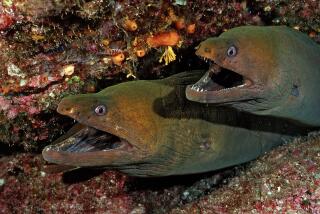Scientists Battle to Stop Spread of Exotic Seaweed
- Share via
HUNTINGTON BEACH — Scientists donned scuba gear and dove into a murky lagoon Monday to try to kill the dreaded Caulerpa taxifolia, an exotic seaweed that could create an ecological nightmare in Orange County’s coastal waters by killing off indigenous sea plants.
Just weeks ago, hundreds of patches of the algae were found in a three-acre pond off Huntington Harbour. Monday’s dive marked the beginning of a $300,000 effort to eradicate the stubborn bloom.
“This is the defensive lineman of seaweed,” said Mark Doalson, an environmental specialist for the Santa Ana Regional Water Quality Control Board.
The algae can grow up to 9 feet long with up to 200 fronds, making it one of the largest single-cell organisms in the world. It can survive 10 days out of the water, and a piece of the algae only 1 millimeter in length can grow into a new plant.
“If this ever gets to Huntington Harbour, things could get pretty ugly,” said Rachel Woodfield, a marine biologist with Merkel & Associates, a San Diego-based consulting firm.
In 1984, the seaweed was accidentally released into the Mediterranean Sea, probably from an aquarium. It quickly bloomed into underwater forests. The seaweed has harmed tourism and destroyed recreational diving across a large area by destroying vegetation and driving away sea life. The seaweed is so pervasive in the Mediterranean, said biologist Andrew Cohen, it is unlikely to ever be eradicated.
The algae found in three different infestations--from the Mediterranean to Southern California--is male and spread from a single parent plant.
The discovery in the lagoon off Huntington Harbour marked only the second time that the bright-green seaweed had been found on the west coasts of North or South America. In July, officials announced the first occurrence of the seaweed in Carlsbad’s Agua Hedionda lagoon, 35 miles north of San Diego. In 1999, scientists got Caulerpa taxifolia listed as a “noxious weed,” making it illegal to import it to the United States, Cohen said.
But the algae still makes its way into the country.
The infestations probably were started by someone dumping strands of the seaweed--which had been popular for use in saltwater aquariums before being banned--from an aquarium into a saltwater environment, Cohen said.
On Monday, Woodfield and colleague Robert Mooney used two techniques to kill the seaweed in the murky waters of the lagoon in Orange County.
Painstaking Work to Remove Seaweed
First, they pulled out individual strands, taking care to yank out at least 10 centimeters below the root-like rhizoids so there is nothing left to regrow, Woodfield said. The scientists planted yellow flags wherever they pulled a seaweed, so they could monitor the location later on.
Second, entire patches were covered with plastic tarps and treated with chlorine to poison the seaweed.
It was tough work. The pond has a foul smell and poor visibility. Flapping stingrays kick up sediment. The water is full of smoothhound sharks, bass, goby fish and yellowfin tuna that have made their way into the artificial pond.
Scientists say the Caulerpa taxifolia outbreak could worsen dramatically.
“If someone introduced a female, that would be very bad,” Woodfield said. “There would be spores floating out there. . . . There’s no way we could stop it.”
More to Read
Sign up for Essential California
The most important California stories and recommendations in your inbox every morning.
You may occasionally receive promotional content from the Los Angeles Times.











